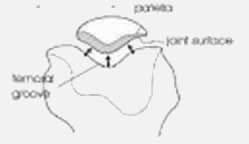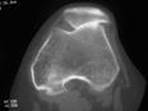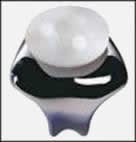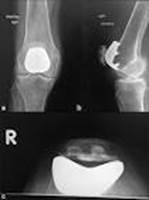Patello-Femoral Joint Replacement
The patello-femoral joint (PFJ) consists of the kneecap and the front surface of the femur on which it glides. The bottom of the patella is keel shaped (like the bottom of a boat) which runs in groove made by the front of the femur ((trochlea)

Diagram showing the PFJ (looking front on to a bent knee)
The PFJ has to withstand huge forces put through it over a lifetime. We have adapted to this by making the cartilage under the kneecap the thickest in the body.
Isolated patello-femoral arthritis is very rare accounting for less than 5% of all knee arthritis. It is usually affected as part of generalised arthritis of the knee which is treated with a total knee replacement.
Symptoms
- Pain around the front of the knee especially going upstairs and getting up from sitting
- Stiffness in the morning
- Night pain

X-ray showing bone to bone contact in the PFJ
If the PFJ alone is affected, then I can perform a PFJ replacement. This involves a midline incision (slightly shorter than TKR wound) through which I can resurface the underside of the kneecap with a high density plastic button which will glide on a specialised metal (oxinium) with which I resurface the front of the femur (trochlea).

Photo of a PFJ replacement. Note the plastic button which is implanted to the under surface of the kneecap and the grooved femoral component on which it glides.

Post operative X-rays
